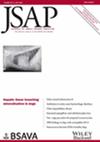Compartmental location of middle ear inflammatory polyps in cats: 9 cases (2021-2023)
Abstract
Objectives
To report the compartmental location of feline aural inflammatory polyps within the tympanic bulla.
Materials and Methods
Nine client-owned cats with clinical signs and middle ear filling consistent with feline aural inflammatory polyps were prospectively pre-selected and underwent unilateral or bilateral ventral bulla osteotomy. Preoperative and surgical findings, complications and outcomes were recorded. Tissues obtained from the ventromedial compartment and from the dorsolateral compartment of the tympanic bulla were submitted separately for histological examination. Definitively selected cats were those having feline aural inflammatory polyps in at least one compartment of their operated tympanic bulla.
Results
Ten ventral bulla osteotomies were performed on nine cats. Feline aural inflammatory polyps were histologically diagnosed in both compartments of all tympanic bullas. There were no intraoperative complications. Apart from Horner's syndrome on the ipsilateral eye following surgeries, post-operative complications were rare. This is the first study that documents the presence of feline aural inflammatory polyps in both compartments of the tympanic bulla in all cats with aural involvement.
Clinical Significance
Should a complete excision of feline aural inflammatory polyps be desired, complete debridement of both compartments of the tympanic bulla is required. Traction-avulsion techniques using approaches of tympanic bulla with no visit of the ventromedial compartment may not completely resolve the condition.

 求助内容:
求助内容: 应助结果提醒方式:
应助结果提醒方式:


